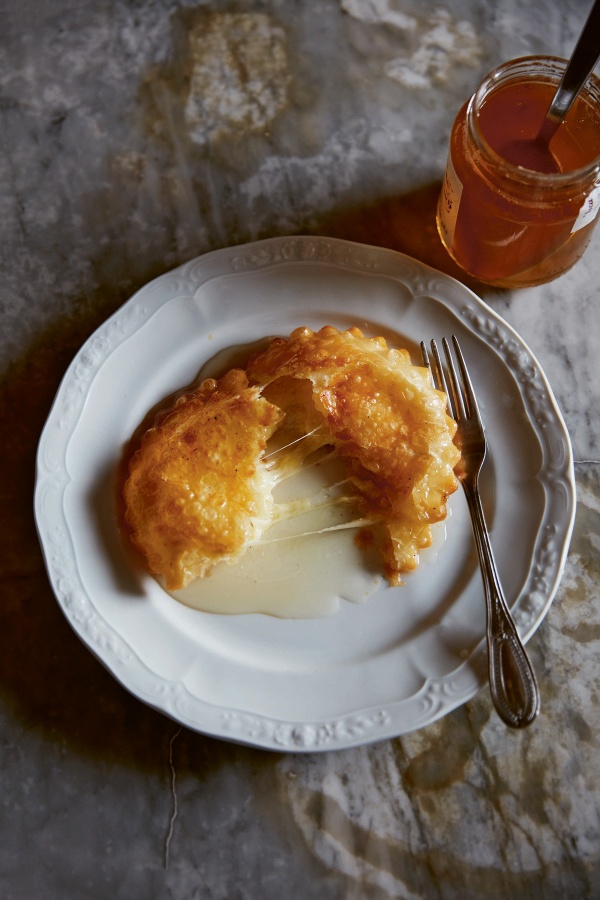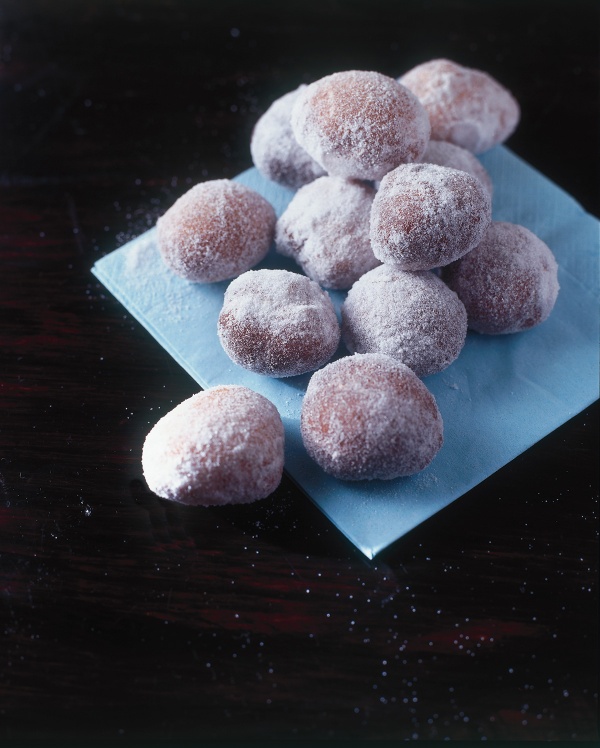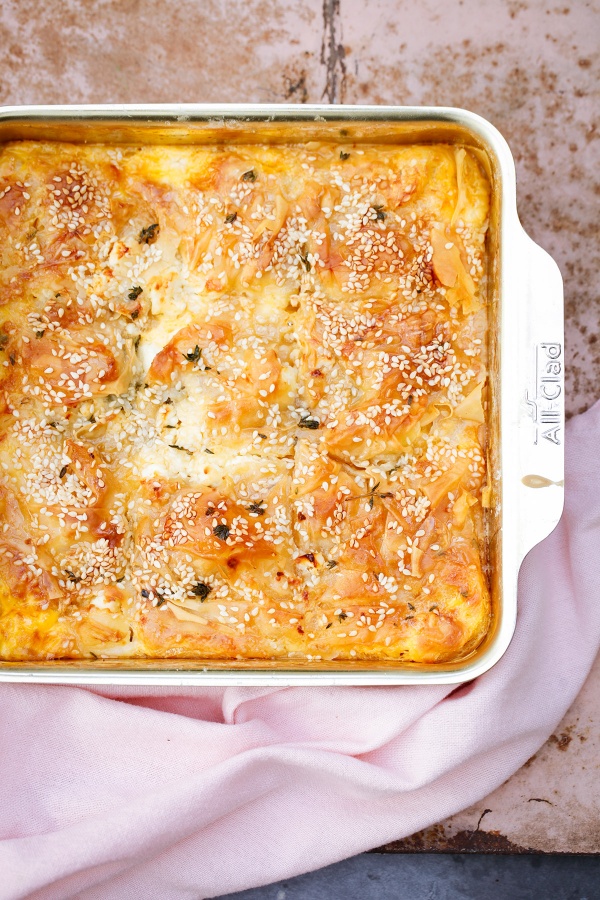Fried Ravioli with Cheese and Honey
by Letitia Clark, featured in Bitter Honey Published by Hardie GrantIntroduction
Also known as Seadas, this is Sardinia's most iconic dessert.
These pastries are a celebration of the simplicity and quality of Sardinian produce: more specifically, cheese and honey.
Traditionally a fresh pecorino is used, which is only aged for a few days and allowed to become slightly sour, then seasoned with lemon zest and encased in a lard-based pastry. The cheesy parcel is then deep-fried until it blisters and puffs and is served, golden and glistening, bathed in honey. Often the honey is the famous miele di corbezzolo, which has a slight bitter-sweetness; a chestnut honey works well too.
If you dislike lard, you can use olive oil or butter, and if you can't find fresh pecorino, try to find a fresh sheeps', goats' or cows' cheese. What is important is that it is rubbery rather than creamy, as this is what gives it the stringy texture when melted.
Also known as Seadas, this is Sardinia's most iconic dessert.
These pastries are a celebration of the simplicity and quality of Sardinian produce: more specifically, cheese and honey.
Traditionally a fresh pecorino is used, which is only aged for a few days and allowed to become slightly sour, then seasoned with lemon zest and encased in a lard-based pastry. The cheesy parcel is then deep-fried until it blisters and puffs and is served, golden and glistening, bathed in honey. Often the honey is the famous miele di corbezzolo, which has a slight bitter-sweetness; a chestnut honey works well too.
If you dislike lard, you can use olive oil or butter, and if you can't find fresh pecorino, try to find a fresh sheeps', goats' or cows' cheese. What is important is that it is rubbery rather than creamy, as this is what gives it the stringy texture when melted.

Share or save this
Ingredients
Makes: 4
For the pastry:
- 1 pinch of sea salt
- 100 grams type 00 flour plus 1 tablespoon more for the filling
- 100 grams semolina
- 20 grams lard (at room temperature)
For the filling:
- 260 grams fresh pecorino cheese (cut into small pieces)
- zest of 1 lemon
- sea salt (optional)
- sunflower oil - for deep-frying
- honey - for drizzling
For the pastry:
- 1 pinch of sea salt
- ¾ cup type 00 flour plus 1 tablespoon more for the filling
- ¾ cup semolina
- ¾ ounce lard (at room temperature)
For the filling:
- 9 ounces fresh pecorino cheese (cut into small pieces)
- zest of 1 lemon
- sea salt (optional)
- vegetable oil - for deep-frying
- honey - for drizzling
Method
Fried Ravioli with Cheese and Honey is a guest recipe by Letitia Clark so we are not able to answer questions regarding this recipe
- Add the salt and 100 ml (3½ fl oz/scant ½ cup) water to the flour and semolina and knead together to form a smooth dough. Now knead in the lard. This should take a good few minutes of steady kneading.
- Wrap in cling film (plastic wrap) and rest for 30 minutes.
- Melt the cheese very gently in a bain marie. When it starts to form one gooey mass, add a spoonful of flour to soak up the liquid that has seeped out. Stir gently and add the lemon zest – if using fresh pecorino, add a pinch of salt here too if you like.
- When the cheese mixture has come together into one melty mass, tip it onto a clean baking (cookie) sheet, spread in into an even layer 1 cm (½ in) thick, and leave to cool and set.
- Meanwhile, roll out your pastry to 1 mm thickness, using either flour or semolina if it gets sticky. Cut circles using a biscuit cutter, around the size of a large orange or small grapefruit.
- Using a smaller cutter or a glass tumbler if you don’t have one, cut smaller circles of the cheese; by now it should be solid.
- Place the circle of cheese in the centre of the circles of dough. Brush around them with a damp pastry brush. Place another circle of pastry on top to sandwich the cheese, and then press down to form little parcels. Seal them well (I cut them into circles again at this point using a ravioli cutter to get nice, even, crinkly edges).
- Place on baking sheet lined with baking paper and keep in the fridge or freezer until ready to serve.
- When you are ready to cook, bring your oil to frying temperature, 190ºC (375ºF). Delicately place the seadas in the oil and fry them until they are golden and crisp. Fish them out with a slotted spoon and drain them quickly on kitchen paper. Serve, drizzled with honey.
- Add the salt and 100 ml (3½ fl oz/scant ½ cup) water to the flour and semolina and knead together to form a smooth dough. Now knead in the lard. This should take a good few minutes of steady kneading.
- Wrap in cling film (plastic wrap) and rest for 30 minutes.
- Melt the cheese very gently in a bain marie. When it starts to form one gooey mass, add a spoonful of flour to soak up the liquid that has seeped out. Stir gently and add the lemon zest – if using fresh pecorino, add a pinch of salt here too if you like.
- When the cheese mixture has come together into one melty mass, tip it onto a clean baking (cookie) sheet, spread in into an even layer 1 cm (½ in) thick, and leave to cool and set.
- Meanwhile, roll out your pastry to 1 mm thickness, using either flour or semolina if it gets sticky. Cut circles using a biscuit cutter, around the size of a large orange or small grapefruit.
- Using a smaller cutter or a glass tumbler if you don’t have one, cut smaller circles of the cheese; by now it should be solid.
- Place the circle of cheese in the centre of the circles of dough. Brush around them with a damp pastry brush. Place another circle of pastry on top to sandwich the cheese, and then press down to form little parcels. Seal them well (I cut them into circles again at this point using a ravioli cutter to get nice, even, crinkly edges).
- Place on baking sheet lined with baking paper and keep in the fridge or freezer until ready to serve.
- When you are ready to cook, bring your oil to frying temperature, 190ºC (375ºF). Delicately place the seadas in the oil and fry them until they are golden and crisp. Fish them out with a slotted spoon and drain them quickly on kitchen paper. Serve, drizzled with honey.






Tell us what you think
Thank you {% member.data['first-name'] %}.
Explore more recipesYour comment has been submitted.